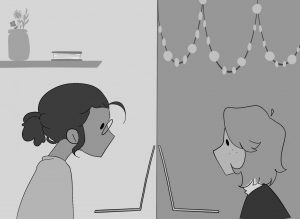DISTANCE LEARNING: Students and teachers reflect on the first semester of distance learning: TEACHERS
February 19, 2021
Compared to the initial transition from in-person to online learning, science teacher Lizzy Estes believes her first full semester in distance learning was noticeably different.
“We all thought it was a temporary shut down, but obviously it ended up being the rest of the school year,” Estes said. “It was hard to make everything work online and digitally with so little notice.”
According to Estes, working online full-time for the first semester of this 2020-2021 school year was a little rocky, but overall a more positive experience.
“I feel like starting school in distance learning was hard because I didn’t know any of my students. It’s been hard getting to know everyone through a screen,” Estes said. “However, I did feel more prepared for teaching and took what I learned from March and used that to turn normal in-class activities into online versions.”
After realizing in the first semester that students can become overwhelmed with all their assignments, Estes has tried to alter her teaching style this semester to accommodate.
“I am going to do my best to cut back on homework and try to do more things in class together. A lot of students expressed they were overwhelmed and stressed because of the workload from all their classes,” Estes said. “I learned that things take a lot longer digitally to complete then if we were in class. It’s better to go slow and not rush things.”
Spanish teacher Amanda Vrabel has found new ways to foster student participation after seeing how breakout rooms can be problematic.
“I noticed things that weren’t working,” Vrabel said. “I’ve been trying this with the breakout groups: If you just are the person that absolutely is not going to speak to a partner … let’s stay with me, and I’ll give you some kind of practice, whether it be in the chat or some other way.”
Vrabel is still adapting, taking her classes one day at a time.
For English teacher Lindsey Couto-Mohamed, directly asking her class what she can improve on has helped her adapt to distance learning.
“I got feedback from students like I always do from a mid-year class evaluation. Some of the changes I’ve implemented are stable workgroups rather than the randomized breakout groups I’d used (in the) first semester,” Couto-Mohamed said. “So students are able to build a comfort level and familiarity. I also have had students keep their cameras on as long as their internet allows for it.”
Like Couto-Mohamed, Therapeutic Program teacher Alex Chavarria found that looking back on previous semesters is beneficial.
“Learning from the spring semester of the previous school year helped.” Chavarria said. “(There are) always areas to improve in.”
With experience, both Chavarria and Couto-Mohamed have come to understand the realities of distance learning and acknowledge the difficulties their students face.
“I completely understand that for some students, technology issues, loud environments with working family members or siblings, and even simply personality types make speaking in class challenging, and I don’t fault them at all, but when the norm became to type all responses, it was a bit demoralizing as a teacher,” Couto-Mohamed said. “That’s improved a bit since students having their cameras on became the norm, but I’d love for students to bring the level of energy to class that they want me as a teacher to have.”
Chavarria is understanding of the situation that COVID has brought upon both students and teachers.
“I understand how difficult it is to learn in this environment. This platform is not conducive for learning, and I empathize with my students.” Chavarria said. “If we all work to communicate together, we can try to make this experience a positive one.”


